
Brown Snake
Latin name: Storeria dekayi
Size: 5 to 15 inches
Venomous: No
This snake species is a very adaptable one, and it is not uncommon to find the brown snake under boulders, rocks, or fallen logs in forests, woods, parks, residential gardens, marshes, swamps, bogs, and grasslands across the state of Virginia. Short but stout, this species is quite elusive, spending more time underground than it does above the surface. This is where it finds its main source of food: the earthworm. When it does spend time above the surface, the brown, tan, or gray colouration with darker and lighter patches camouflages it very well in vegetative surroundings.
Northern Copperhead
Latin name: Agkistrodon contortrix mokasen
Size: 25 to 40 inches
Venomous: Yes
Also known as the harlequin snake, deaf adder, white oak snake, and a host of other names, the copperhead is highly venomous, but very rarely bites. In actual fact, the pit viper tends to give off a warning shot or two before actually biting to inject venom, lunging and striking but without actually making contact. The majority of bites happen when they are startled; upon first sighting of a predator, the snake is known to freeze completely still and allow camouflage to work its magic. With the snake freezing and the human not knowing the snake is hidden in vegetation, stepping on or near the viper is often what leads to conflict.
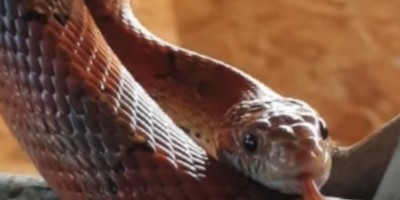 Red Corn Snake
Red Corn Snake
Latin name: Pantherophis guttatus
Size: Up to 70 inches
Venomous: No
Corn snakes are a mostly nocturnal species, more active at night when rats, mice, and birds are also active (the species’ primary food sources). Birds are also on the menu, and juvenile corn snakes will also eat small frogs, toads, and lizards. The snake has a relatively amicable temperament and is very secretive, often spotted hiding underneath large boulders or rock piles, although they are very adept climbers and can also be seen in trees and on/in the upper levels of buildings in commercial or residential areas.
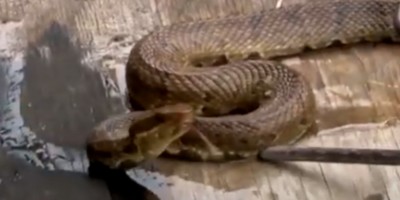 Eastern Cottonmouth
Eastern Cottonmouth
Latin name: Agkistrodon piscivorus piscivorus
Size: 20 to 48 inches
Venomous: Yes
The northern cottonmouth goes by a number of other names (rusty moccasin, stub-tail, black moccasin, mangrove rattler, and highland moccasin, to name but a few) and is regularly mixed up with a variety of other snakes, including the northern water snake and water moccasin. In the state of Virginia, it is also commonly referred to as the northern cottonmouth. Cottonmouth species tend to inhabit the south-west and south-east of the state of Virginia, commonly found in freshwater creeks, swamps, marshes, streams, ponds and lakes, as well as the areas surrounding them.
Southeastern Crowned Snake
Latin name: Tantilla coronata
Size: 5 to 10 inches
Venomous: No
The southeastern crown snake is a thin-bodied snake that barely grows to more than 10 inches in length, often appearing a solid brown or brown-gray color, without a pattern running down the length of the body. The head is black, usually with a paler band at the neck, giving it the ‘crowned’ name. Also known as the eastern backfanged snake (because of its rear-facing fangs), the ground snake, and the blackheaded snake (because of the black head, it is actually mildly venomous but very rarely bites humans, and the venom is not thought to affect humans.
Mountain Earth Snake
Latin name: Virginia valeriae pulchra
Size: 7 to 10 inches
Venomous: No
You would need to rummage through leaf litter or soft, moist soils in order to find the mountain earth snake, one of three subspecies of earth snake found in the south-east US. It doesn't have many defense mechanisms to work with, apart from its small size, so it prefers to stay hidden than risk predation from humans or other larger predators. This snake is almost always a brown color and is commonly referred to as quite ‘drab’ looking, but some specimens have been a more rust-red shade of brown, and others have been almost completely gray. As juveniles, the body tends to be patterned, but this darkens and fades away with age.
Rough Earth Snake
Latin name: Haldea striatula (Formerly known as Virginia striatula)
Size: 7 to 10 inches
Venomous: No
The rough earth snake eats primarily earthworms, using its pointed snout to rummage around underground to dig them out. Other insects are eaten when the number one food choice is scarce, including insect larvae, snails and slugs, ants, and others. This snake has been known by a number of other names over the years, and has also even had its latin name amended a couple of times, and it is often confused with other snakes, including the brown snake (or DeKay's snake) and the smooth snake. This particular species has fewer markings than the brown snake, and the rough scales (keeled) sets it aside from its aptly named smooth snake cousin.
Eastern Garter Snake
Latin name: Thamnophis sirtalis sirtalis
Size: 18 to 26 inches
Venomous: No
The eastern garter snake is the official state snake of Virginia, and is also referred to by the names: garden snake, common striped snake, Churchill’s garter snake, broad garter snake, and dusky garter snake, as well as a few others. It eats any food that is small enough to eat, which regularly includes earthworms, snails, slugs, toads, frogs, insects, and occasional small fish, which it finds in shrubby fields and moist grasslands, around bodies of water, and in quarries. It is also common to find the eastern garter snake in urban settings, in residential parks and back gardens, and also on farmland.
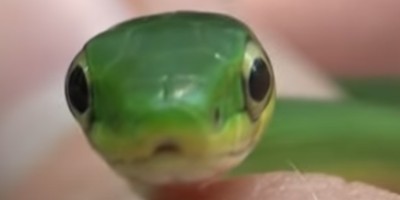 Smooth Green Snake
Smooth Green Snake
Latin name: Opheodrys vernalis
Size: 14 to 20 inches
Venomous: No
The smooth green snake is often found in habitats that are moist or wet, with plenty of open, grassy areas. This can include prairies, open woods, pastures, the edges of streams and lakes, meadows, marshes, and swamps. The green colouration gives this slender snake camouflage, so it prefers to stay in green, grassy areas. Being a shy snake, it is a bigger fan of fleeing from predators (humans) than it is sticking around to inevitably lose the battle. The smooth green snake, just as the name might suggest, has smooth dorsal scales, unlike its rough green snake cousin, which has keeled scales.
Northern Rough Green Snake
Latin name: Opheodrys aestivus
Size: 20 to 35 inches
Venomous: No
Although not a species of special concern, it is believed that populations of the northern rough green snake are on the decline in the state of Virginia, due to predation from household pets and strays, degradation of habitat, and also the increased use of pesticides and other chemicals which kill off the snake's main prey — caterpillars, butterflies, moths, grasshoppers, crickets, spiders, larvae, and other insects. A green snake with slightly rough scales (unlike the smooth green snake, which has smooth scales) that lives in forests and woodlands and spends almost all of its time up in the trees. The green colouration gives it perfect camouflage in the leaves, and it sleeps coiled up on the logs and branches.
Eastern Hog-Nosed Snake
Latin name: Heterodon platirhinos
Size: 15 to 42 inches
Venomous: No (Yes, but it doesn't affect humans)
The eastern hog-nosed snake is a species of snake commonly found in Virginia, with an upturned nose that resembles that of a hog, just as the name would suggest. The colouration of this snake can vary greatly from region to region, and even just from snake to snake, with some being a tan or brown color with darker, almost black spots, and others solid black. Also known as the spread-head moccasin, deaf adder, blowing adder, black blowing viper, and a wide assortment of other, similar names, the eastern hog-nosed snake is moderately sized, quite stocky, and feeds mostly on toads, such as American and southern toads.
Eastern King Snake
Latin name: Lampropeltis getula getula
Size: 36 to 48 inches
Venomous: No
This non-venomous snake is also referred to by a string of other weird and wonderful names, such as the thunderbolt snake, master snake, thunder-and-lightning snake, and common king snake — but there's one reason you should be happy that the eastern king snake exists: it helps to keep populations of the copperhead snake down — which is a venomous species. The closer you get towards the coast, the more patterned this dark, usually black snake seems to be. Inland specimens can be almost entirely black in color, with individuals from coastal plains having wider and often brighter bands.
Eastern Black King Snake
Latin name: Lampropeltis nigra
Size: 35 to 48 inches
Venomous: No
The eastern black king snake can be found in the south-west regions of the state of Virginia, inhabiting wetlands such as swamps, marshes and streams, as well as highly-vegetated lands around them; and also in fields, farms, and edge-of-town properties. It is an adaptable snake that can live in an array of habitat types, and in some places across the US, this is one of the most common snakes encountered. With a slightly white-speckled but mostly black body, occasionally with cross-bands (but this seems to be dependent on area), it can look very similar to other snakes also found in Virginia, such as the northern black racer and eastern rat snake.
Mole King Snake
Latin name: Lampropeltis calligaster rhombomaculata
Size: 30 to 40 inches
Venomous: No
You will find the mole king snake in the eastern two-thirds of the state of Virginia, where it is sometimes mixed up with the non-venomous milk snake, or the venomous copperhead. Unlike other subspecies of king snake, this snake is not just black in color, but tends to be a brown or gray color, decorated with dark red, uneven patches. A nocturnal species, some people report seeing the snake on roads at night, particularly after it has rained. Rain also tends to force the snakes above ground. Aside from that, they tend to spend a lot of time underground, or hiding beneath debris found on the forest floor.
Scarlet King Snake
Latin name: Lampropeltis elapsoides
Size: 14 to 20 inches
Venomous: No
The scarlet king snake appears striped — red, black and white or yellow in color. They mimic the colouration and markings of the venomous coral snake, but unlike the coral snake, the scarlet king snake's yellow and red bands do not touch. There is a band of black separating them, which is how you can tell a venomous red-black-yellow snake from a non-venomous one. Pine flat-woods and cultivated fields are the territory of choice for this snake, but it's becoming more and more common for them to enter residential areas. Calls for king snakes in backyard swimming pools are on the increase.
Eastern Milk Snake
Latin name: Lampropeltis triangulum triangulum
Size: 24 to 36 inches
Venomous: No
The eastern milk snake is a common species found within the pet trade, and with specific color and marking breeding as well as the release of pets back into the wild (accidentally or otherwise), it is now a snake that comes in a wide range of patterns and colours. In Virginia, eastern milk snakes that are found in mountain and hillside areas (higher elevations) are more blotchy or patchy than those found in the lowlands, and in the south-east of the state.
Eastern Mud Snake
Latin name: Farancia abacura abacura
Size: 50 to 54 inches
Venomous: No
Also known by a host of other names, including the thunder snake, eastern horn snake, North-American red-bellied snake, and checkered snake — it has a red belly, a mostly dark black body, and checkerboard appearance where the red belly and black top-body meet. Commonly found in areas close to water, such as swamps and marshes, it is a very shy and secretive species that prefers murky water with lots of vegetation. It is here that it finds its main prey items: fish, frogs, salamanders, earthworms, and various other amphibians.
Northern Pine Snake
Latin name: Pituophis melanoleucus melanoleucus
Size: 45 - 70 inches
Venomous: No
Head to the western Appalachian mountains in the state of Virginia to spot the northern pine snake, also known as the white gopher snake, black and white snake, carpet snake, common pine snake, and common bull snake. This snake species is harmless, more prone to defense than attack, and it even mimics the tail of a venomous rattlesnake to try and ward off predators, including humans.
Smaller juvenile pine snakes eat mostly lizards, insects, and the occasional small mammal; but as the snake ages, it chooses to feed more on rodents, birds, slightly larger mammals, and the eggs of both birds and mammals.
Queen Snake
Latin name: Regina septemvittata
Size: 13 to 30 inches
Venomous:No
Some may know this semi-aquatic species by a few other names, such as North American seven-banded snake, brown queen snake and banded water snake. As the many names suggest, this snake is a water-based snake (in or around), is commonly brown in color, and has seven bands. This snake is quite unusual when compared to other, similar species in Virginia because of the stripes that run along the length of the belly.
A snake that mostly feeds on crayfish, it must live in freshwater, rocky-bottomed bodies of water that can support crayfish populations. As these decline, the populations of queen snake decline — and they are a species of great concern in some states.
Northern Black Racer
Latin name: Coluber constrictor constrictor
Size: 36 to 60 inches
Venomous: No
As you'd probably expect, the northern black racer is a mostly black snake, shiny to look at, and with a paler, gray underside. There is usually a brown segment on the snout, and a white-ish area around the neck — this is what you might see when the snake pops its head above long grasses to look around and find predators or prey.
They eat a wide range of prey items, which they coil around to pin in place (but don't usually suffocate) before eating, including other snake species, toads and frogs, lizards, rats and mice. Although it will put on a defensive display before attacking, bites are common from the northern black racer.
Common Rainbow Snake
Latin name: Farancia erytrogramma erytrogramma
Size: 25 to 50 inches
Venomous: No
Also known as the eel moccasin, the common rainbow snake is every bit as colorful as the name would lead you to believe, with stripes of bright red, blue-black, and bright orange-yellow. The tail is pointed, and the females are usually larger than males, although it is not common to see this species out in the wild. Almost all of its time is spent in the waters of sandy coastal plains, marshes, cypress swamps, and slow-moving rivers or streams. The subspecies of the common rainbow snake found in Virginia is now the only one left; the southern Florida rainbow snake was, sadly, declared extinct back in 2011.
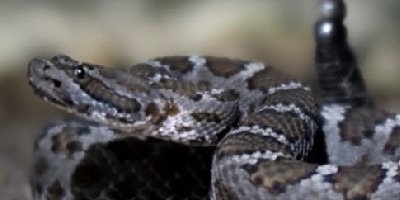
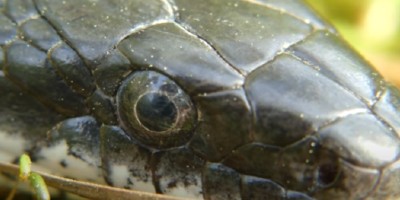 Eastern Rat Snake
Eastern Rat Snake
Latin name: Pantherophis alleghaniensis
Size: 36 to 72 inches
Venomous: No
The eastern rat snake is the only snake in the state of Virginia that has the capability to grow longer than six feet in length, but it is a relatively harmless snake, non-venomous, and one of the most spotted snakes in the whole of the state. Rat snakes are very adaptable in nature, and the eastern rat snake can live in a wide variety of habitats, including forests, wetlands, farmlands, and isolated woodlots. They follow their main food source, which is rats and mice, and this can often lead them into old buildings and barns — and they have been known to follow the scent of prey for some distance, too. They are one of the most common snakes in Virginia to become roadkill.
Timber Rattlesnake
Latin name: Crotalus horridus
Size: 36 to 60 inches
Venomous: Yes
Although usually a yellow-brown, gray, or caramel brown color with darker patterns that closely resemble cross-bands, the timber rattlesnake can come in a wide range of colours and markings, and some have been known to be almost entirely one color of very dark brown or black, making it appear much like other snakes, including venomous snakes. In some cases, the only way to identify the species is to take a look at the number and way that the scales are arranged across the body, but we don't recommend getting that close as the rattlesnake is a venomous species.
Northern Red-Bellied Snake
Latin name: Storeria occipitomaculata occipitomaculata
Size: 8 to 16 inches
Venomous: No
This snake species is found in abundance across moist and cool woodlands of mixed and deciduous trees, but it is not uncommon to find them in residential areas, especially in back yard flower beds, and also on farmland, river and lake-edges, and sphagnum bogs. This is where it finds the majority of its prey: earthworms, slugs, snails, and other insects with soft bodies. The varied coloring and markings of the northern red-bellied snake can make it appear more like other species, including Kirtland's snakes, brown snakes, ring-necked snakes and garter snakes.
Common Ribbon Snake
Latin name: Thamnophis saurita saurita
Size: 18 to 26 inches
Venomous: No
Also known as the eastern ribbon snake, the ribbon snake gets its name for being long and slender — like a ribbon. Similar to the garter snake, the body is usually dark in color (black or dark brown/gray), with three white-yellow stripes. One runs down the length of the back, and there’s one down each of the sides. The garter snake is plumper than the ribbon snake and is also usually patterned with small spots in between the stripes. This snake normally feeds at night, in bodies of water, preying on small fish and various other amphibians — toads and salamanders. Insects are also commonly eaten.
Northern Ring-Necked Snake
Latin name: Diadophis punctatus edwardsii
Size: 10 to 15 inches
Venomous: (Yes, but it doesn't affect humans)
Although quite a small snake, the northern ring-necked subspecies has been known to grow a lot larger than the expected 10 to 15 inches — to as long as 24 inches. The cloudy black/dark gray, solid-colored snake has a ring around the neck, separating the head from the body, giving it its name. The ring itself can be orange or cream-yellow, and it often matches the paler color of the underbelly. The northern ring-necked snake generally has a complete ring around the throat area, unlike other subspecies, which tend to have a broken ring. As well as that, the northern subspecies usually doesn't have spots along its underbelly; the other subspecies does.
Southern Ring-Necked Snake
Latin name: Diadophis punctatus punctatus
Size: 10 to 15 inches
Venomous: (Yes, but it doesn't affect humans)
With rear-facing fangs, very mild venom, and a non-aggressive nature, the southern ring-necked snake is ever-so-slightly venomous, but doesn't pose problems for humans. In fact, the shy and secretive nature of this species means that you will probably never see one. The snake itself isn't a very large one, and it is usually dark and easily hidden in the ground coverage it chooses to hide itself in. There are 14 recognized subspecies of ring-necked snake, and the southern subspecies is just one that you’ll find. Unfortunately, breeding between the southern and northern varieties in the state has made it much tougher to differentiate between the two.
Northern Scarlet Snake
Latin name: Cemophora coccinea copei
Size: 14 to 20 inches
Venomous: No
The bulk of this nocturnal snake's diet is made up of the eggs of other reptiles and snakes, and it even has teeth that are oversized to help smash through eggs that it can’t manage to swallow whole. When eggs aren't an option, lizards, small snakes, and frogs do for a tasty meal. It looks venomous, mimicking the colourations of venomous snakes (such as coral snakes), but it is a relatively harmless species that rarely bites at humans even when handled. The patches of bright color are bordered by black stripes (red and yellow do not touch), which is how you can tell it is of the non-venomous variety.
Eastern Glossy Swamp Snake
Latin name: Liodytes rigida rigida
Size: 14 to 24 inches
Venomous: No
This snake is known by a host of other names in Virginia, including the brown water snake, rigid queen snake, and striped moccasin as well as a few others. It is a semi-aquatic and heavy-bodied snake that is commonly found in fresh water that has plenty of vegetation. This can mean anything from roadside ditches to tidal marshes, swamps and ponds, and they are even occasionally spotted crossing roads during rainy nights. It is probably going to be more so the case that you never spot this snake in the wild, even if you try; they are incredibly elusive, are known to slither off into the water at the first sign of trouble, and have a range of defense mechanisms, including a vile-scented musky fluid, to ward you off.
Brown Water Snake
Latin name: Nerodia taxispilota
Size: 30 to 60 inches
Venomous: No
The non-venomous brown water snake is also known by a wide variety of other names, including the water-pilot, false water moccasin, great water snake, and water rattle — and it is a usually tan or light brown color, with splats of dark brown that almost look square in shape. It's a heavy-bodied snake, often confused with the venomous water moccasin, and as the name would imply, it spends almost all of its time in or around water, such as streams and swamps. It especially uses water as a way of fleeing predators and danger.
Northern Water Snake
Latin name: Nerodia sipedon
Size: 20 to 55 inches
Venomous: No
All snakes are carnivorous, but the northern water snake is often considered to be the reptile equivalent of a rat. It is a scavenger species, eating a wide variety of water-based foods, including dead fish, live fish, smaller snakes, frogs, toads, tadpoles, leeches, crayfish, and turtles. They also eat land animals — small birds, mice, and rats. This species of snake uses the water to flee from predators, and the snake is known to be able to hold its breath under the water for up to an hour and a half when necessary. They have a range of defences to try and keep predators at bay, including releasing a musky and unpleasant-smelling fluid, deliberately defecating, vomiting (if they have recently eaten), and biting.
Plain-Bellied Water Snake
Latin name: Nerodia erythrogaster
Size: 24 to 40 inches
Venomous: No
The plain-bellied water snake is quite a unique water snake in the fact that it flees on land rather than fleeing in the water, but this is a snake species that, despite being mostly aquatic, is perfectly capable of living away from a body water, and traveling great distances from a body of water to find food. Females give birth to quite a large number of live young, during the summer — as many as 55 in a single litter. The larger the female is, the more juveniles she is capable of birthing. Sadly, many of the juveniles will die from predatory attacks before they reach adulthood.
Eastern Worm Snake
Latin name: Carphophis amoenus amoenus
Size: 7 to 11 inches
Venomous: No
The eastern worm snake is one of, if not the most common snakes found in northern regions of the state of Virginia, and the snake is known to do well and increase numbers quickly when conditions are ideal – adequate food sources, nesting spots, etc. The worm snake eats a varied diet, but will mostly prey on worms and insects, particularly ones with soft bodies/without shells. It is often believed that the worm snake has a spined tip, but this is not true. It is shaped a little like a spike, but it is relatively harmless. The tail is actually mostly used to help the snake move around as it burrows around underground.